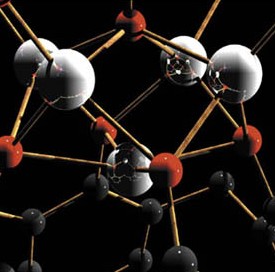Scientists measured the speeds of the particles in the molecule, when they analyzed the movement of the four particles that make up a molecule of deuterium. A theoretical analysis of such a system is a challenge, because at the moment there is no detailed model for making a comparison between the experimental findings and a theoretical calculation
Alluvial container, Galileo

Direct link to this page: https://www.hayadan.org.il/whatismolecule.html
How is a molecule built? What are the distances between the particles in it, what are their speeds, and what are their directions of movement? Quantum mechanics provides the answers to these questions - and as such, does not deal with point particles with precise location and speed, but with clouds of probability. The more complex the molecule, the more difficult it is to perform calculations that will give a clear picture of what is happening inside the molecule, and take into account the electron orbits, the nuclear vibrations and their mutual effects.
A group that includes scientists (Thorsten Weber, Reinhard Dorner and colleagues) from around the world published an article in Nature, in which research dealing with the dynamics of the particles within a molecule is presented. The researchers analyzed the movement of the four particles that make up a molecule of deuterium (heavy hydrogen): two electrons, and two nuclei, each containing a proton and a neutron. The experiments were conducted in Berkeley laboratories in California.
During the experiment the molecule was bombarded with photons; Absorption of photon energy usually results in the release of a single electron, but the release of both electrons may also occur. In such a case there is no longer a force that would hold the two positive nuclei bound as a molecule. They repel each other, and the molecule breaks up.
Such cases have been investigated using particle detectors. Electric and magnetic fields directed the particles to the measuring instruments which picked up the "fragments" of the molecule and measured their speed. When the speed is known, as well as the times of occurrence in the system, the forces acting on it after the disintegration and the position of the molecule before it disintegrated, it is possible to reconstruct the movement of the particles within the molecule at the moment of its disintegration.
If the process that causes the disintegration of the molecule is sufficiently understood, conclusions can be drawn from the findings regarding the dynamics of the particles in the bound state, that is, before the damage occurred. A photon is a particle without mass and electric charge, so its interaction with the molecule (known as "scattering") is relatively simple.
In the motion analysis it can be assumed that the photon only changed the speeds of the electrons, while the nuclei of the atoms, which are relatively heavy, were found at the moment of disintegration in the same state they were in before the impact. After the separation, only the electrical repulsion acting between them changes their speeds.
This repulsion depends on the distance between them, and from the measurement of the final velocity one can get an idea of the initial distance separating the nuclei. It is also possible to learn about the effect of this distance on the movement of electrons. It turns out that the movement of electrons depends closely on the distance between the nuclei.
A theoretical analysis of such a system is a challenge. There is currently no model detailed enough to make a comparison between the experimental findings and a theoretical calculation. The models created by the experimenters did not fully explain the observations, especially the nature of the dependence between the electron movement and the distance between the nuclei.
Physics expert
https://www.hayadan.org.il/BuildaGate4/general2/data_card.php?Cat=~~~63376524~~~95&SiteName=hayadan
